by Beth Bolles | Jun 10, 2017
It is common in Northwest Florida for palms to show signs of nutrient deficiencies. In general our sandy soil is often nutrient poor and available nutrients can easily move out of soils with frequent rainfall. In landscapes where fertilization is occurring, often the wrong types of fertilizer are applied. Fertilizer miss-application actually increases nutrient problems for the palm.
Palms can be deficient in many nutrients but the most common deficiencies we see in landscapes are from inadequate amounts potassium and magnesium. The simple solution would be to purchase a fertilizer labeled for palms to correct the problem. The difficulty is that most easily available fertilizers for palms do not have the correct form of nutrients that are required for the problems. With the exception of nitrogen, all other nutrients are in a quick release form so while the slow release nitrogen lasts for 2-3 months, all other nutrients have been used up. In response, the palm is encouraged to grow by the nitrogen but does not have enough of the other critical nutrients to carry out vital plant functions. What we see is often older leaves that are yellowing, browning, and die off before they should because the plant is pulling any available potassium and magnesium from old fronds to support new growth. Without the application of proper nutrients to the soil, the deficiency can continue until even new fronds are affected or the palm dies.
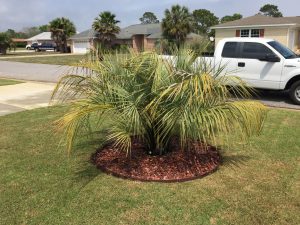
The fertilizer used for lawns does not have all the slow release and correct forms of nutrients for the palms. Older leaves turn yellow and brown indicating potassium deficiency. Photo by Beth Bolles, UF IFAS Extension Escambia County.
There is a solution that will help keep your palms healthy and attractive. Make sure you choose a specially designed fertilizer that has all nutrients in slow release form. Look for an analysis such as 8-2-12-4 (Nitrogen-Phosphorus-Potassium-Magnesium). Also read further on the label for Polymer Coated Sulfate of Potash, Magnesium Sulfate (Kieserite), and Chelate (Iron EDTA). These are the forms of nutrients that will be beneficial to your palms.
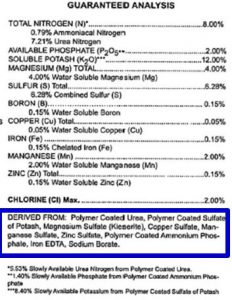
Look in the area ‘Derived From’ (outlined in blue) on your fertilizer label to find the forms of nutrients. Photo by Dr. Monica Elliott, US/IFAS Extension.
If you have a mixed landscape where the palms are planted in the lawn, be sure to keep all lawn fertilizers out of the root zone of the palms. Lawn fertilizers do not have the correct forms of nutrients for palms. Remember also that palms roots extend many feet beyond the palm canopy so your ‘no lawn fertilizer zone’ may be past the mulch ring.
The recommendation from the University of Florida is 1.5 pounds of fertilizer over a 100 square foot area. Broadcast this on top of the ground and lightly water after application. In North Florida, you will likely apply the correct palm fertilizer about at least two times in May and end of August or 1st of September. If you are not able to use a palm fertilizer with the correct form of slow release nutrients, it is best not to fertilize palms at all.
by Mark Tancig | May 25, 2017
One of the main Florida-Friendly Landscaping principles is to plant the right plant in the right place. In Florida, not only does this apply to the zone you’re in, soils you have, and light conditions in your garden, but also ensuring that invasive, exotic plant species are not used. While most of us have heard about invasive, exotic plants – those that invade and disrupt our unique natural habitats – some may not know where or how to find out which plants are, in fact, invasive and exotic. Some of the more famous invasive, exotic plant species, such as kudzu and hydrilla, are familiar to us and we may have an idea of a plant in our garden that is “aggressive”, but how do we know for sure? Since only a handful of the worst invasive, exotic plants are legally prohibited from being sold, how do we know if a plant we are considering purchasing at our local nursery or another plant already in our gardens is an invasive, exotic? A quick internet search for Florida invasive plants gets you various sources of information. How do you choose which to use?

The unique habitats of Florida need our help. Prevent the spread of invasive, exotic species by planting Florida-Friendly plants. Source: Mark Tancig/UF/IFAS.
Fortunately, the researchers at UF/IFAS want you to be able to find the best information in one spot – the UF/IFAS Assessment of Non-Native Plants in Florida’s Natural Areas. This site systematically reviews individual plant species and provides a recommendation as to whether it should be used in North, Central, or South Florida landscapes. Many landscape plants have been reviewed – over 800 – and more are added to the site as reviews are completed. The UF/IFAS Assessment also reviews cultivars of known invasive, exotic plants to ensure that they are sterile and will not revert back to their wild type or hybridize with known invasives, or even closely related native species.
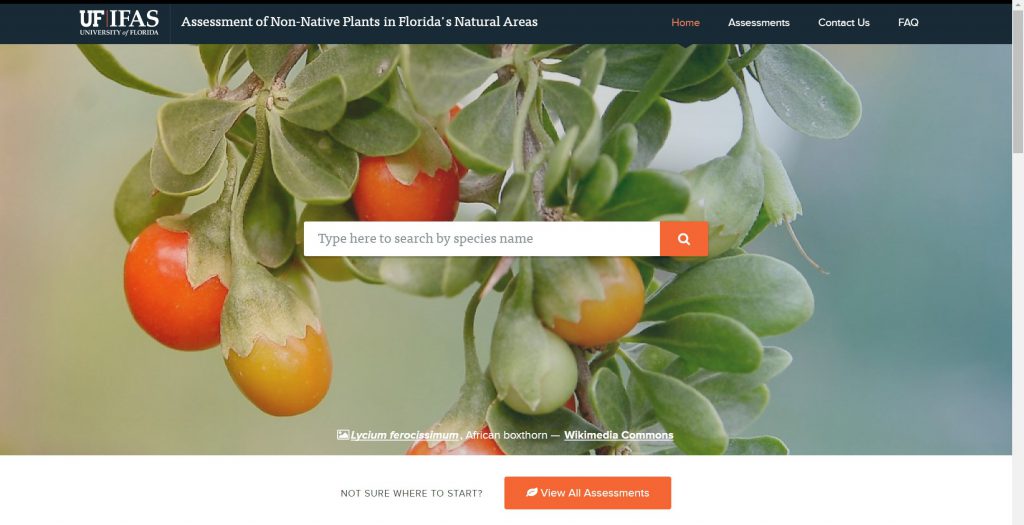
The UF/IFAS Assessment is a simple, convenient source for deciding if a plant should be used in your Florida landscape.
To use the site, simply visit the main web address – assessment.ifas.ufl.edu – and begin typing in your plant name in the search bar. You can begin spelling the scientific or common name and it will start showing possible results as you type. Once you select the plant you’re interested in, it will take you to a new page with photos of the plant, some general information, additional links, and, most importantly, the assessment conclusion for each zone. The conclusion will be one of the following:
- Not considered a problem species at this time,
- Caution, or
- Invasive
Of course, if it’s not a problem, then feel free to use and share that particular plant. If it is a caution plant, then it may be used, but you will want to be extra careful in where you plant it. Those may be better suited as potted plants or planted in areas that are confined, to limit its potential spread. If it’s invasive, don’t plant it.
Caution plants are reassessed every two years while those that are not considered a problem species or are considered invasive are reassessed every ten years.
Another way to use the UF/IFAS Assessment is to filter all reviewed plants by various criteria you’re interested in. If you select assessments on the main page, it will lead you to a list of all reviewed plants. A filter button allows you to choose geographic zone, conclusion type, and growth habit, among some other criteria. This will create a list that can then be exported to a Microsoft Excel table.
As you can see, UF/IFAS is trying to make it easy for you to determine which plants can be used in the landscape without potentially spreading and causing disruption to our unique natural areas.
If you have any questions about individual species that have or have not been assessed, contact your local County Extension Office.
by Ray Bodrey | May 25, 2017
This time of year, people flock to nurseries and garden centers to purchase trees or shrubs that will enhance their landscapes. However, there are certain management measures to keep in mind to ensure plant establishment. Depending on the season, newly planted trees and shrubs need varying degrees of watering, mulching, pruning and trunk staking.
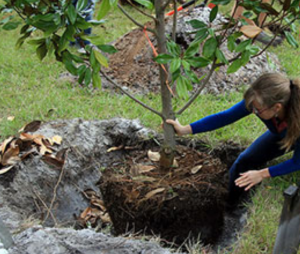
Figure 1: Tree Planting.
Credit: UF/IFAS Communications.
The primary focus in care of your newly planted tree or shrub is root development. It takes several months for roots to establish, and newly planted trees and shrubs do not have a very strong root system. Start by digging the hole in a popcorn bowl shape. Once planted, backfill around the root system, but be careful not to compact the soil. Compaction will hinder root growth. Be sure to keep the topmost area of the root ball exposed, about two inches. A layer of mulch will be applied here.
Frequent watering is much needed, especially if you are planting in the warmer months. Water thoroughly, so that water percolates below the root system. Shallow watering promotes surface root growth, which will make the plant more susceptible to stress during a drought. Concentrate some of the water in a diameter pattern of a few feet from the trunk. This will cause the root system to grow towards the water, and thus better establish the root system and anchor the tree.
Mulch is important in the conservation of soil moisture. Pine needles, bark and wood chips make a great mulch for ornamental shrubs. A two to three inch layer of mulch will usually suffice. It’s important to keep the mulch at least a few inches from the trunk. Mulching too close to the tree trunk can cause trunk rot.
You should always prune the bare roots of trees and shrubs during planting. Exposed roots in containers can be damaged in shipping. Removing some of the roots will also help trigger growth. In addition, pruning some of the top foliage can reduce the amount of water needed for the plant to establish.
Newly planted trees and shrubs often have a difficult time establishing if the root system cannot be held in place. Strong winds and rain can cause the plant to tip over. Avoid this by staking the plant for temporary support. A good rule of thumb for plant staking is if the trunk diameter measures three inches or less. Tie the stake to the plant at every six inches from the top. However, only tie the trunk at one spot. Don’t tie too tightly, so that the tree has no flexibility. This will stunt the growth of the plant.
Larger trees and shrubs will need diameter staking with wire support. Four stakes evenly spaced at six feet around the trunk is a good arrangement. Each stake can be attached to the tree just above the mid-point using cable or wire. Be sure to cover the wire around the trunk with a short piece of hose to prevent any scarring of the bark. The wire should be snug, but not tight. After one year, the staking can be removed.
Following these tips will help ensure your tree or shrub becomes well established in your landscape. For more information please contact your local county extension office.
Supporting information for this article can be found in the UF/IFAS EDIS publication: “Specification for Planting Trees and Shrubs in the Southeastern U.S.” by Edward F. Gilman: http://edis.ifas.ufl.edu/pdffiles/EP/EP11200.pdf
Supporting information also provided by UF/IFAS Extension Forestry Specialist Dr. Patrick Minogue, of the North Florida Research Education Center in Quincy, Florida.
UF/IFAS Extension is an Equal Opportunity Institution.
by Larry Williams | May 11, 2017
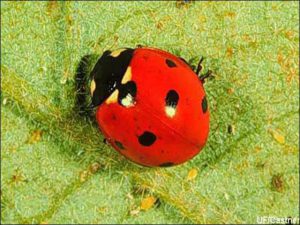
Adult Ladybug. Photo Credit: James Castner University of Florida
A number of summers ago, I noticed whiteflies on a confederate rose plant in my landscape. I considered using an insecticide to control the whiteflies but decided against doing so after taking a closer look. What I found was a population of ladybugs – eggs, larvae, pupae and adults.
Ladybug adults and larvae eat whiteflies, as well as other soft-bodied insects such as aphids. So, I waited to see what would happen.
At first I was seeing mostly adult whiteflies, which look like tiny white moths. Adult whiteflies mate and then lay eggs on the underside of leaves. The eggs hatch into flat translucent scale-like nymphs that suck the “juice” from the underside of the leaves.
Eventually, some of the leaves developed a black coating called sooty mold. As certain insects (primarily aphids, some scales and whiteflies) feed, they excrete plant sap that coats the leaves. Sooty mold then grows on this sugary sap. It’s not a pathogen. It just makes the leaves look ugly.
Knowing that the whiteflies would not kill the confederate rose, I was willing to tolerate the sooty mold and allow the ladybug population to build.
Allowing whiteflies to live on your plants may not always be the best option. But in order to have beneficial insects in your landscape, there must be some “bad” insects for them to eat.
Insects such as ladybugs, lacewings and praying mantises eat many pest insects. Encouraging these beneficial insects can allow you to reduce the amount of pesticides applied.
It’s important to learn to recognize the adult and immature stages of these beneficial insects. Ladybugs have larvae that look nothing like
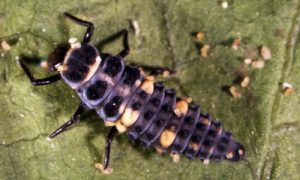
Ladybug larva. Photo credit: Aristizabal University of Florida
the adults. Some ladybug larvae look like small orange and black alligators. Others may resemble mealybugs. Many gardeners that would never kill adult ladybugs mistake their larvae as pests and kill them with insecticides.
The following UF/IFAS Extension website will help you learn to recognize many of our beneficial insects. http://edis.ifas.ufl.edu/topic_beneficial_insects
Once you find beneficial insects in your landscape, reduce or eliminate the use of insecticides. When an insecticide is needed, use environmentally friendly options such as insecticidal soaps, horticultural oils and products that contain Bacillus thuringiensis (Bt).
Sometimes a heavy stream of water from a water hose is all that is needed to remove pest insects from plants and reduce their numbers to an acceptable population.
Remember, leaving a few pest insects is a great way to attract beneficial insects. Tolerating a minor infestation and a little plant damage will benefit the helpful insects, your pocketbook and the environment.
by Julie McConnell | May 1, 2017
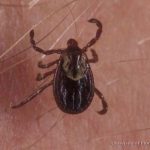
American Dog Tick. Photo: L. Buss, UF/IFAS
You’ve probably heard some tips to prevent picking up ticks in the past, but did you ever wonder why some work and others don’t? Understanding the life cycle and behavior of common ticks can help you succeed with your prevention measures.

Life Cycle of American Dog Tick. Credit: Centers for Disease Control
A general life cycle for ticks includes four life stages: egg, larva, nymph, and adult. The egg hatches into larva which require a blood meal to molt into a nymph which again requires a blood meal before molting to an adult.
The adult female also requires blood feeding in order to produce eggs, which she lays in high numbers – some species lay up to 6,500 eggs!
Because blood is required for development, ticks have to be resourceful in finding hosts. Knowing this can help you understand why some tips work better than others.
Tick Tips
-
Wear clothing that covers skin and avoid sitting on the ground or logs in brushy areas. Adult ticks exhibit a behavior called “questing” where they climb to the top of grasses and vegetation with their forelegs extended and wait for a host to come by. The American Dog Tick‘s primary host are dogs, but they will also target cattle, horses, and humans.
-
Apply repellents to exposed skin and clothing (different products are labeled for where they are applied, follow all directions). These chemicals repel ticks and can reduce likelihood of tick attachment, but ticks have been known to crawl over treated areas to access untreated body parts.
-
Keep grass and vegetation maintained and clean up debris that may harbor small mammals and rodents. Early in the tick life cycle it targets smaller animals for blood and they can
hide or shelter in debris piles and vegetation.
-
Always shower and check yourself for ticks after being in areas where ticks may live, especially when temperatures are warm. Nymphs can be less than 1 mm long, so check carefully!
For instructions on how to properly remove a tick that has embedded, visit UF Health Tick Removal.
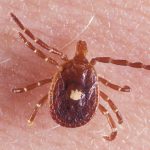
Female Lone Star tick that has not fed. Photo: L. Buss, UF/IFAS
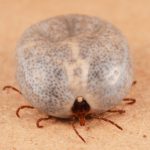
Lone Star Tick female engorged on blood. Photo: L. Buss, UF/IFAS
by Beth Bolles | May 1, 2017
We may shy away from drama in our lives but drama in the garden is always welcome. One plant series that will be a prominent feature in any garden bed is the Amazon Dianthus series.
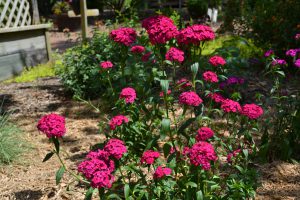
Amazon Dianthus series is showy in the garden or in a container. Photo by Beth Bolles, UF IFAS Extension Escambia County
Although we normally consider Fall the time to plant dianthus, the Amazon Series developed by PanAmerican Seed company can be planted in Spring for blooms that extend into Summer. This is the combination of two dianthus and the results are plants with striking colors and longer blooming cycles.
The Amazon series comes in a few bright colors including Amazon Neon Cherry, Amazon Neon Pink, and Amazon Rose Magic. Flowers are held on stems about 1.5-2′ tall and foliage is an attractive dark green. Plants are generally low maintenance but be sure to deadhead flowers as they fade. Plants will need rich, well drained soil and full sun.
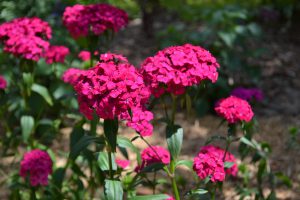
Neon Cherry. Photo by Beth Bolles, UF IFAS Extension Escambia County
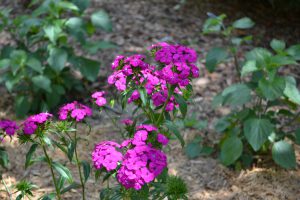
Neon Pink. Photo by Beth Bolles, UF IFAS Extension Escambia County
If you don’t have room for the Amazon dianthus series in your landscape, plants will also grow well in containers to brighten a patio or deck.














